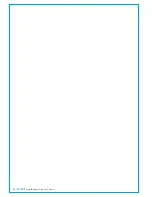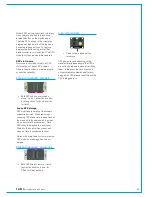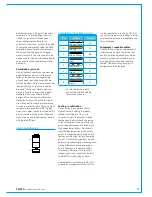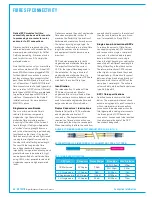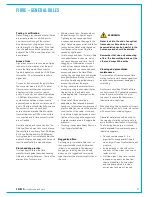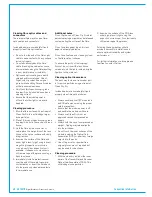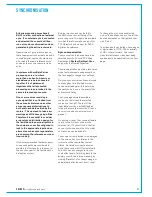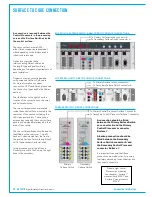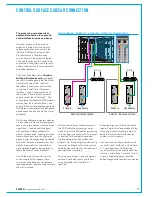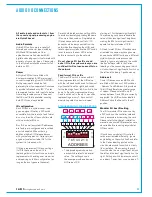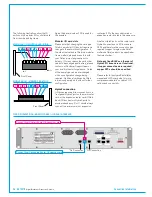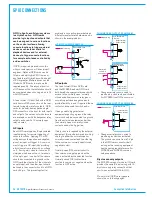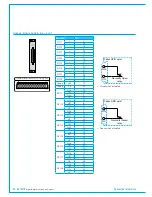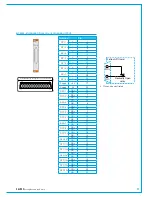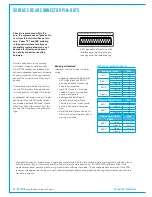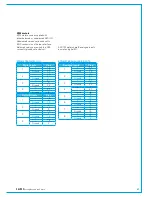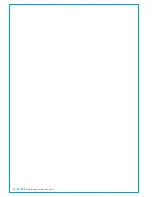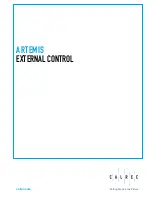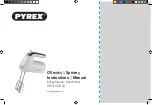
CALREC
Putting Sound in the Picture
53
AUDIO I/O CONNECTIONS
All audio inputs and outputs to / from
the console signal processing engine
are Hydra2 based.
AudioFormats
Hydra2 I/O units come in a variety of
formats and connector types including
MADI and SDI embedders / de-
embedders as well as standard AES
digital and analogue mic/line formats with
a variety of connector types. Please refer
to the Hydra2 installation manual for full
details on I/O.
Power
All Hydra2 I/O units are fitted with
dual power supplies & IEC mains input
connectors operating from 100-240VAC.
Both power inputs should be fed,
preferably from two separate AC sources
to provide full redundancy. IEC 'Y' cords
are supplied to allow both inputs to be fed
from a single cable source in the event
that this is all that is available, ensuring
both PSU's can always be fed.
IDconfiguration
Each I/O box in a system needs to be
given a unique ID, set by a DIP switch
accessible from the rear of a fixed format
box, or on the side of the controller card
within a modular I/O box.
Box ID's, as well as system IP addresses
are factory pre-configured and recorded
prior to despatch. When ordering
additional Hydra2 I/O, please discuss
with your sales person or Calrec project
engineer to select suitable ID's for the
system it is to be used with.
If fitting a replacement I/O box, settings
its ID to the same as the unit it is
replacing allows it to function as a drop in
replacement with existing user memories
and requiring no further configuration (as
long as the box types are the same).
Care should be taken when setting HID’s
to avoid accidentally duplicating the same
ID on more than one box. Duplicate box
ID’s can cause network conflicts. I/O
boxes should be disconnected from the
network before changing their HID, and
reset or power cycled once the DIP switch
is set to ensure the new HID is active
before reconnecting to the network.
Do not change I/O box IDs or add
extra I/O to the system unless you are
confident it will not cause a conflict on
the network.
Fixed format I/O box IDs
The 8 way DIP switch is set as an 8 bit
binary representation of the HID value
with the left hand switch used for the most
significant bit, and the right hand switch
for the least significant bit. A switch in the
down / off position represents a binary
0 and a switch set in the up / on position
representing a binary 1. Each switch /
binary bit equates to a decimal value,
starting at 1 for the least significant bit.
The remaining switches are double the
value of their less significant neighbour,
making the 8th / most significant bit
equate to a decimal value of 128.
All fixed format I/O box ID switches are
orientated the same way, though some
boxes, such as MADI units, use a different
style switch with more pronounced
labelling. Ignore any labels on the switch
itself and always refer to the Calrec
labelling on the surrounding panel which
will show the most significant bit switch on
the left and the binary 1 position as up.
Address2
Some I/O boxes, such as MADI units
are fitted with 2 banks of DIP switches
- Address 1 and Address 2, to provide a
16 bit ID and therefore a greater range
of values. Please note that only ID
values between 0 and 255 are currently
supported. Any DIP switches labelled
Address 2 should all be set to the off
position.
ModularI/OboxIDsetting
The ID for modular I/O boxes is set by
a DIP switch on the controller card and
is only accessible by removing the card.
Please refer to the Hydra2 installation
manual and ensure ESD precautions are
observed before removing any modular
I/O box cards.
ID switches on modular I/O controller
cards are orientated differently. Ignore
any labelling on the switch itself and refer
to the Calrec labelling printed on the
circuit board around the switch to clarify
its’ orientation. When viewing the card
from the side, the most significant bit is on
the left and the least significant bit on the
right. Pulling a switch towards you sets it
as a binary 1, away from you as a binary 0.
1
1 0
2
3
4
5
6
7
ADDRESS
0
1
0
0
0
1
0
0
1
1
1
128 64 32 16 8
4
2
1
32
4
2
1 =
+
+
+
39
STANDARD SWITCH FOR HID SETTING
• The above diagram shows how
each switch relates to a decimal
value. The setting shown in
the example provides a decimal
HID value of 39
Summary of Contents for Artemis
Page 5: ...calrec com Putting Sound in the Picture ARTEMIS INFORMATION...
Page 9: ...calrec com Putting Sound in the Picture ARTEMIS CONTROL SURFACE...
Page 26: ...26 ARTEMIS Digital Broadcast Production Console...
Page 27: ...calrec com Putting Sound in the Picture ARTEMIS PROCESSING CORE BEAM SHINE...
Page 33: ...calrec com Putting Sound in the Picture ARTEMIS PROCESSING CORE LIGHT...
Page 40: ...40 ARTEMIS Digital Broadcast Production Console...
Page 41: ...calrec com Putting Sound in the Picture ARTEMIS CONNECTION INFORMATION...
Page 66: ...66 ARTEMIS Digital Broadcast Production Console...
Page 67: ...calrec com Putting Sound in the Picture ARTEMIS EXTERNAL CONTROL...
Page 80: ...80 ARTEMIS Digital Broadcast Production Console...
Page 81: ...calrec com Putting Sound in the Picture ARTEMIS SETUP CONFIGURATION...
Page 100: ...100 ARTEMIS Digital Broadcast Production Console...
Page 101: ...calrec com Putting Sound in the Picture ARTEMIS PANEL OPTIONS...
Page 110: ...110 ARTEMIS Digital Broadcast Production Console...
Page 111: ...calrec com Putting Sound in the Picture ARTEMIS OBSOLETE PANELS...
Page 114: ...114 ARTEMIS Digital Broadcast Production Console...
Page 115: ...calrec com Putting Sound in the Picture ARTEMIS SPECIFICATIONS...


